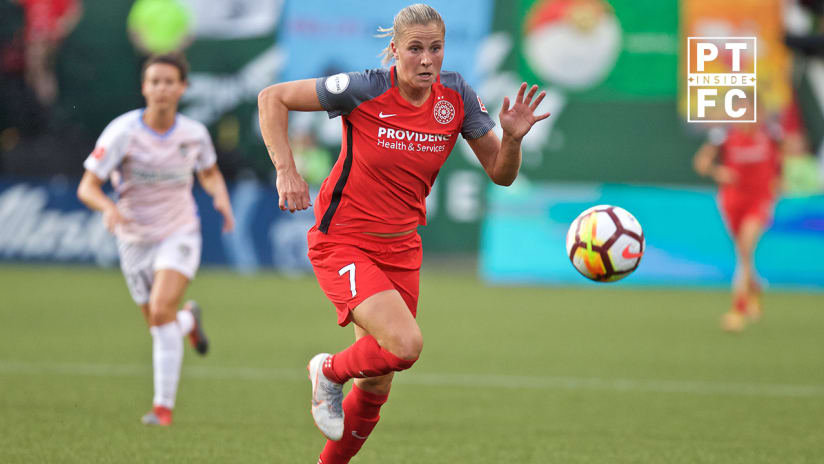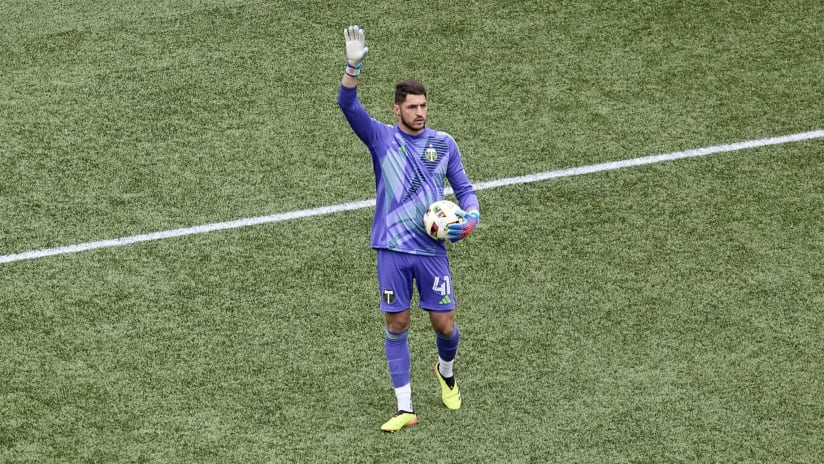The finish was by the book, going back across goal as Sky Blue FC’s Caroline Casey hustled to cover for her mistake. In truth, the goal by Ana Crnogorčević was less impressive than her finishes against Houston, the week before, or the one against Utah, the week before that. For the third game in a row, the Switzerland international had gotten herself onto the scoresheet, only this time, she’d gotten a little help.
These are the kinds of conversations we’ve been waiting to have around Portland Thorns FC’s early-season acquisition, but through her nine games in the NWSL we couldn’t rank her goals. She only had one – a scavenging tally in Houston that was surrounded by two separate four-game droughts. Now, on five goals through 15 appearances, Crnogorčević is living up to her pre-arrival billing, with her current per-minute scoring rate projecting her to 9.59 goals over a full, 24-game NWSL season.
Player |
GP |
GS |
MIN |
G |
S |
SOG |
|---|---|---|---|---|---|---|
Ana Crnogorčević |
15 |
13 |
1126 |
5 |
29 |
14 |
It’s tempting to see the before and after of Crnogočević’s form and think that the Thorns forward has turned a corner, and undoubtedly, there’s an element to that in play. The confidence the former 1. FFC Frankfurt standout has shown over her last month-plus hints she’s found her comfort level within a new league. But entailed in the doubt that had surfaced around her early returns – the skepticism that mounted in murmurs after a single goal in two months – there’s something to learn about how we evaluate goal-scorers. Too often, our conversations are just too blunt, and we don’t factor in the inherent variance that does into collecting goals.
Consider the following range of outcomes you get when you design a Monte Carlo simulation to see how a scorer with Crnogorčević’s current numbers would typically perform over full seasons. For those unfamiliar with a Monte Carlo method, the idea is to get a better idea of variance inherent in an observation by designing a simulation that you run repeatedly, giving you some information on how often outcomes are likely to occur.
As it concerns Crnogorčević, I wrote a program which took her scoring rate and – asking on a minute-by-minute basis how likely it is that she would score a goal, producing a “yes” (goal) or “no” (no goal) outcome – assessed the probability should would score a goal over a game’s worth of minutes, a season’s worth of games, and 10,000 seasons.
The result was the range of outcomes we could expect from 10,000 different goal/225.2-minutes scorers:
Goals |
No. |
Pct. |
|---|---|---|
0 |
0 |
0 |
1 |
9 |
0.09 |
2 |
53 |
0.53 |
3 |
174 |
1.74 |
4 |
403 |
4.03 |
5 |
613 |
6.13 |
6 |
907 |
9.07 |
7 |
1218 |
12.18 |
8 |
1311 |
13.11 |
9 |
1310 |
13.10 |
10 |
1195 |
11.95 |
11 |
926 |
9.26 |
12 |
713 |
7.13 |
13 |
482 |
4.82 |
14 |
292 |
2.92 |
15 |
188 |
1.88 |
16 |
1.01 |
1.01 |
17 |
53 |
0.53 |
18 |
32 |
0.32 |
19 |
11 |
0.11 |
20 |
8 |
0.08 |
21 |
0 |
0.00 |
22 |
1 |
0.01 |
Some important details: The simulations only played Crnogorčević 75 minutes per game – the number she is averaging through her first 15 NWSL appearances. It also only played 22 games per season instead of the NWSL maximum 24, thinking that injury or international absence will always make it unlikely players of Crnogorčević’s stature will play 24-game seasons. And, of course, this whole article assumes Crnogorčević’s five goals in 1126 minutes approximates a scoring rate that reflects her actual level (in truth, it’s almost surely higher or lower).
As for the results, 68.7 percent of Crnogorčević’s simulated seasons fall within the range of six-to-11 goals. In the craziest simulation, Crnogorčević had a 22-goal season – five more than the NWSL record – while in only 0.6 percent of these simulated seasons did Crnogorčević perform consistent with that one-goal-in-nine-games stretch that defined her first NSWL action.
It looks very likely that slow start was aberrational and, if it is, our assumed scoring rate for Crnogorčević is too low. But for now, let’s stick with the data we have.
Another thing we can do with these simulations – something that truly informs how we should have contextualized Crnogorčević’s start – is track how often players with these goal rates put up long scoreless streaks. Crnogorčević has two four-goal droughts, thus far. How often should we expect that to happen?
For each of the simulated seasons, I also recorded what, within that season, was the player’s longest goal drought. The result:
Longest Stretch |
No. |
Pct. |
|---|---|---|
0 |
0 |
0 |
1 |
4 |
0.04 |
2 |
186 |
1.86 |
3 |
1028 |
10.28 |
4 |
1954 |
19.54 |
5 |
1935 |
19.35 |
6 |
1584 |
15.85 |
7 |
1114 |
11.14 |
8 |
797 |
7.97 |
9 |
523 |
5.23 |
10 |
334 |
3.34 |
11 |
220 |
2.20 |
12 |
123 |
1.23 |
13 |
82 |
8.20 |
14 |
48 |
4.80 |
15 |
31 |
0.31 |
16 |
16 |
0.16 |
17 |
8 |
0.08 |
18 |
10 |
0.10 |
19 |
3 |
0.03 |
It is extremely likely a scorer like Crnogorčević will have, within a season, a significant scoring drought. In fact, 76.2 percent of simulated seasons included a drought of three-to-seven games, while only 1.9 seasons didn’t include a goalless three that went beyond two games. If a scorer at this rate even went six games without scoring? It’s probably not work worrying about. That’s roughly a one-in-six outcome.
This is where some repetition might be helpful, if only to emphasize what we’re actually doing. Scoring, like almost everything in life, has some variance baked into it concerning when and how often it happens. That means Crnogorčević doesn’t score exactly every 225.2 minutes. Her goals come at varying times, occasionally in bunches. It means the same player, with the same skill, can produce a wide range of outcomes, and have a wide range of droughts.
On a theoretical level, it can be seen in terms of potentials – potential in more of the chemical sense, not an athlete’s career arc. At any minute, a player like Crnogorčević has a certain potential to score a goal. How often does that happen? Not very often, but if you assess that probability – the potential – over a huge series of seasons, you see the range of outcomes somebody who scores every 225.2 minutes is likely to produce.
These caveats rarely make their way into conversations when we’re talking about strikers. You don’t often hear the person across the table, bar or aisle say, “yeah, but this is really just a 15.8 percent outcome.” So, when Crnogorčević had one goal in nine games, it was natural to wonder whether she needed time to adjust.
But it would have also been right to note that, sometimes, good strikers have stretches where they don’t score goals. And whether it’s Crnogorčević start, Samuel Armenteros’s acclimation period (no goals in eight games), Fanendo Adi’s form (two goals in 13) or whatever Caitlin Foord does when she takes the field, we could stand to be slightly more sophisticated in how we evaluate strikers’ runs.














